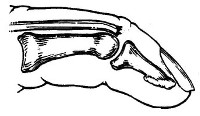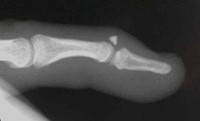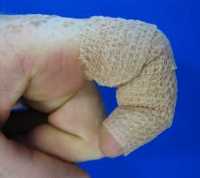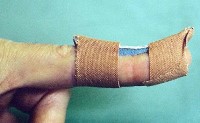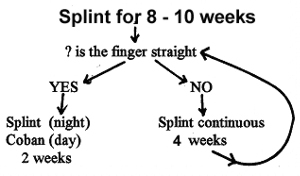Mallet Finger
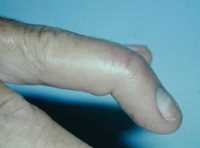
A sudden bending force to the tip of the finger causes a Mallet finger. Eg while tucking in the sheets while making a bed.
It results in a drooping deformity at the end joint of the finger.
If left untreated the deformity can increase progressively over time.
It can either:
1. Stretch or Rupture the tendon:
Treatment: Splint for 10 weeks
2. Pull a fragment of bone off the end bone of the finger
Treatment: Splint for 8 weeks
3. Fracture involving > 50% joint surface
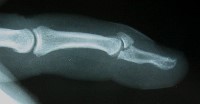
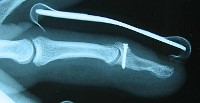
Treatment: Surgery may be indicated
4. Fracture dislocation of the D.I.P. joint.

This is uncommon and requires surgery.
Treatment with Splints:
The fingertip should be held straight for 8 - 10weeks to allow the tendon to heal.
This is followed by a period of night splinting & the use of Coban bandage during the day for 2 weeks.
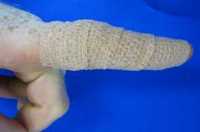
Note - the finger must be kept dry if using an aluminium splint. With the new splint material ( Rheenatherm) patients can wet the finger.
- the splint should be comfortable. If the finger is painful then the splint can be carefully removed & the back of the finger massaged with an alcohol swab to prevent ulcer formation. During this time the finger must be supported straight at all times. If the finger drops for even one second the treatment can fail. The splint is best reapplied with the assistance of another person or a hand therapist.
- If the splint feels too tight it usually is and should be carefully adjusted
- As the swelling & pain settles the splint can be bent back more to decrease the strain on the tendon. If the tape stretches new tape can be applied over the top of the old tape. The finger should feel firm in the splint
- The second finger joint (P.I.P. joint ) should be exercised to prevent stiffness
Aluminium Splint:
Rheenatherm splint:
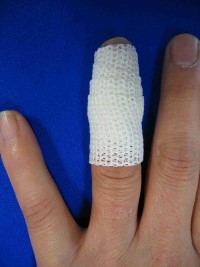
- Surgery is rarely required for this condition unless the end joint (D.I.P. joint) is dislocated. Surgery often results in permanent loss of bending (flexion) of the end joint & the results of treatment in the splint are very good if the program is carefully followed.
- After the splintage period the finger should be gently exercised. It is best to regain full bend of the finger over a period of 6-8 weeks rather than force the movement and end up rupturing the tendon again.
- Coban bandage can be obtained from the physio. 5 layers should be applied to the finger loosely to partially restrict the movement of the end joint for 2 weeks after the splint is removed
Summary
If finger drops or is still bent after 8 weeks then re-apply splint 3 - 4 weeks and return for review.
The Bottom line!
If the finger drops for even one second during the splintage period the treatment can fail!!!!!!!.
Revised 29 / 3 / 15

